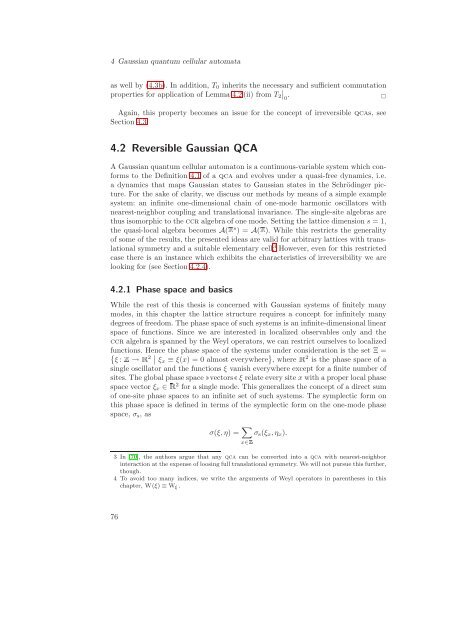Quantum Information Theory with Gaussian Systems
Quantum Information Theory with Gaussian Systems
Quantum Information Theory with Gaussian Systems
You also want an ePaper? Increase the reach of your titles
YUMPU automatically turns print PDFs into web optimized ePapers that Google loves.
4 <strong>Gaussian</strong> quantum cellular automata<br />
as well by (4.3b). In addition, T0 inherits the necessary and sufficient commutation<br />
properties for application of Lemma 4.2(ii) from T2<br />
. 0 <br />
Again, this property becomes an issue for the concept of irreversible qcas, see<br />
Section 4.3.<br />
4.2 Reversible <strong>Gaussian</strong> QCA<br />
A <strong>Gaussian</strong> quantum cellular automaton is a continuous-variable system which conforms<br />
to the Definition 4.1 of a qca and evolves under a quasi-free dynamics, i.e.<br />
a dynamics that maps <strong>Gaussian</strong> states to <strong>Gaussian</strong> states in the Schrödinger picture.<br />
For the sake of clarity, we discuss our methods by means of a simple example<br />
system: an infinite one-dimensional chain of one-mode harmonic oscillators <strong>with</strong><br />
nearest-neighbor coupling and translational invariance. The single-site algebras are<br />
thus isomorphic to the ccr algebra of one mode. Setting the lattice dimension s = 1,<br />
the quasi-local algebra becomes A(s ) = A(). While this restricts the generality<br />
of some of the results, the presented ideas are valid for arbitrary lattices <strong>with</strong> translational<br />
symmetry and a suitable elementary cell. 3 However, even for this restricted<br />
case there is an instance which exhibits the characteristics of irreversibility we are<br />
looking for (see Section 4.2.4).<br />
4.2.1 Phase space and basics<br />
While the rest of this thesis is concerned <strong>with</strong> <strong>Gaussian</strong> systems of finitely many<br />
modes, in this chapter the lattice structure requires a concept for infinitely many<br />
degrees of freedom. The phase space of such systems is an infinite-dimensional linear<br />
space of functions. Since we are interested in localized observables only and the<br />
ccr algebra is spanned by the Weyl operators, we can restrict ourselves to localized<br />
functions. Hence the phase space of the systems under consideration is the set Ξ =<br />
ξ:→Ê2 ξx ≡ ξ(x) = 0 almost everywhere , whereÊ2 is the phase space of a<br />
single oscillator and the functions ξ vanish everywhere except for a finite number of<br />
sites. The global phase spacevectorsξ relate every site x <strong>with</strong> a proper local phase<br />
space vector ξx ∈Ê2 for a single mode. This generalizes the concept of a direct sum<br />
of one-site phase spaces to an infinite set of such systems. The symplectic form on<br />
this phase space is defined in terms of the symplectic form on the one-mode phase<br />
space, σs, as<br />
σ(ξ, η) = <br />
x∈σs(ξx, ηx).<br />
3 In [70], the authors argue that any qca can be converted into a qca <strong>with</strong> nearest-neighbor<br />
interaction at the expense of loosing full translational symmetry. We will not pursue this further,<br />
though.<br />
4 To avoid too many indices, we write the arguments of Weyl operators in parentheses in this<br />
chapter, W(ξ) ≡ Wξ .<br />
76
















